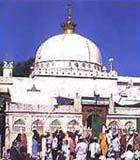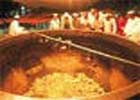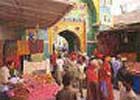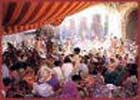Ajmer is venerated as a holy place for both Hindus and Muslims. It has
the mausoleum of the Khwaja Moinuddin Chishti, a great Sufi saint who
came to Ajmer from Persia in 1192.
Known as the Dargah Sharif and Khwajia Sharif, the last resting place
of the saint who died in 1235 after a six-day prayer in seclusion.
These six days in the month of May are celebrated every year as the
annual Urs which is attended by innumerable pilgrims irrespective of
their faith. The grave of the Sufi Saint is surrounded by a silver
railing and is partially covered with a marble screen.
The shrine is considered to be a place of wish fulfilment for those
who pray with devout and pure hearts. The saintís marble domed
mausoleum receives an endless flow of pilgrims of all religions as the
sick, the troubled and the childless come here seeking a boon, a
blessing or just peace of mind. It is said that emperor Akbar, after
conquering Chittaurgarh in 1567, paid his first visit to the shrine as
a token of thanksgiving. His second trip was made after he had his first
son and later, he visited the Dargah annually.
The entry to the Dargah is through the Dargah Bazar that leads to the
inner courtyard. The mausoleum has a gigantic gate, which was built by
the Nizam of Hyderabad. The high gateway has beautifully carved silver
doors. In the courtyard are kept two huge cauldrons with capacity of
2240 kg and 4480 kg.
On special occasions, 'Kheer' (sweet rice
garnished with dry fruits and condiments to be served as Ďtabarukhí
or sanctified food.) cooked in these cauldrons and is distributed among
the pilgrims.
Within the dargah lies a mosque, built by the Mughal Emperor Shah Jahan.
Like all of Shah Jahanís buildings, the mosque too, is an architectural
marvel - a magnificent building in white marble with a long and narrow
courtyard for the faithful to pray in, richly embellished with ornate
calligraphic inscriptions, delicate carvings and detailed trelliswork.
The daughter of Shah Jahan had built a prayer room in the Dargah for
the women devotees.
Festivals and Fairs |
   |




